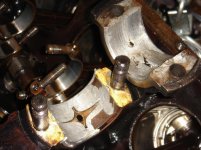Mud
Diamond
- Joined
- May 20, 2002
- Location
- South Central PA
These photos are of the mains in an early flathead Ford. The first photo is of the center main. The Babbitt wiped out of the bottom, and material broke out of the top and piled up in the bottom closing up the vertical clearance, but leaving clearance at the sides. This made a really odd knock swinging side to side and was hard to diagnose, but that's another story.
The second photo is of the rear main, you can see pieces missing and more cracked and ready to leave. The missing pieces stuck to the oil on the crank and lifted out with the crank.
I've only scraped existing bearings, I've never poured babbitt or seen this kind of failure where the material falls out of the casting. Is this a typical failure, or were they incorrectly poured?
The engine is a '36 in a pickup I bought in '72 but haven't driven much until recently. I bought it from the original owner who drove it every day. He told me the original engine was replaced by the Ford dealer with a Ford rebuilt engine because of a crack. There's a metal tag riveted to the bellhousing that could be a rebuilder's tag, but it's unreadable. The cylinders are standard size, so if it is a rebuilt it must have been a very low mileage engine to start with. The crank is standard size and looks like you could polish it and reuse it. By the crud on the outside of the motor, I'd guess the motor was put in about 1950-1955.
Anyone have experience with this? I'm wondering what the likelihood is of this happening again, if I rebabbit the block I have.


The second photo is of the rear main, you can see pieces missing and more cracked and ready to leave. The missing pieces stuck to the oil on the crank and lifted out with the crank.
I've only scraped existing bearings, I've never poured babbitt or seen this kind of failure where the material falls out of the casting. Is this a typical failure, or were they incorrectly poured?
The engine is a '36 in a pickup I bought in '72 but haven't driven much until recently. I bought it from the original owner who drove it every day. He told me the original engine was replaced by the Ford dealer with a Ford rebuilt engine because of a crack. There's a metal tag riveted to the bellhousing that could be a rebuilder's tag, but it's unreadable. The cylinders are standard size, so if it is a rebuilt it must have been a very low mileage engine to start with. The crank is standard size and looks like you could polish it and reuse it. By the crud on the outside of the motor, I'd guess the motor was put in about 1950-1955.
Anyone have experience with this? I'm wondering what the likelihood is of this happening again, if I rebabbit the block I have.




 ) It ran well for one summer. the next summer it started to knock, It was parked all this last summer. When I first got it out I was very concerned about starting it for the first time, but it survived and lasted one season. The only sign of heavy wear is the center main cap, and I think that's the babbitt failing, not a lube issue. All the rest upper and lower bearings are unworn, just cracked and flaking. I'll post 2 more photos, of the rear cap and the front upper.
) It ran well for one summer. the next summer it started to knock, It was parked all this last summer. When I first got it out I was very concerned about starting it for the first time, but it survived and lasted one season. The only sign of heavy wear is the center main cap, and I think that's the babbitt failing, not a lube issue. All the rest upper and lower bearings are unworn, just cracked and flaking. I'll post 2 more photos, of the rear cap and the front upper.

